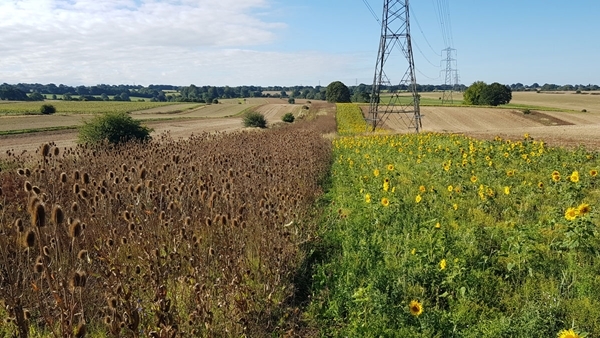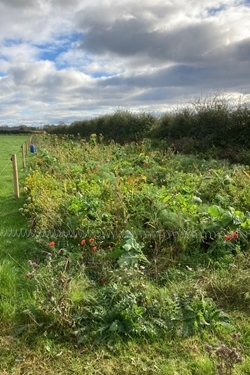A new ‘Wildlife Plot’ agri-environment option, which promises to be one of the best yet for biodiversity, has been developed as part of the GWCT’s PARTRIDGE Project on the Rotherfield Estate in Hampshire. Containing more than 20 species and based on years of research across Europe into the ideal combination of plants to maximise biodiversity, the new option is now available to farmers through government-funded schemes.

Francis Buner, GWCT Senior Conservation Scientist, who co-designed and trialled the option in collaboration with Oakbank Game and Conservation, said: “I’m delighted that Defra has recognised the potential for this measure to significantly boost biodiversity. Many of the wild bird and pollinator mixes currently available are limited in what they can deliver. They often contain fewer than ten species of plant, predominantly non-natives or cultivars, and need to be re-established at least every other year, leaving a big gap with no cover, food or shelter in spring and into early summer. Whereas the Wildlife Plot has 20 species, mostly native perrenials, providing food and nesting habitat for insects and birds all year round.”
The ‘Advanced PARTRIDGE’ seed mix developed at Rotherfield was the prototype for the Wildlife Plot option and can be ordered from Oakbank. A similar mix is available from Kings. Both qualify as a wild bird mix option AB9, but those in or about to apply for Mid Tier schemes will require a derogation from Natural England to manage them as Wildlife Plots. The Sustainable Farming Incentive (SFI), which will replace Countryside Stewardship as the main constituent of the ELMS scheme, has the Wildlife Plot as a recognised option.
In sampling studies carried out this year, Advanced PARTRIDGE mix was the best wild bird seed mix in the country for insects, both in quantity and variety of species. Scientist Steve Moreby from the GWCT’s Farmland Ecology Unit said: “Both first- and second-year plots contained more of the key grey partridge chick food insects when compared to other mixes. This looks to be a very promising mix and we hope to sample more sites in 2022 to see how it performs on different soils, field and farm types.”
 The mix can be sown in 1ha blocks or minimum 15m wide strips on the edges of arable or grass fields, making space for nature alongside modern farming. As well as providing year-round food, its structure has been carefully designed to create ideal habitats for a wide range of farmland wildlife. Francis explained: “I’ve seen nesting whitethroat, stonechat and skylark in the mix; watched kestrel, barn owl and long-eared owls hunting for mice; and small warblers, whinchat and redstart use it during migration. I’ve even spotted a red-listed grasshopper warbler in there.”
The mix can be sown in 1ha blocks or minimum 15m wide strips on the edges of arable or grass fields, making space for nature alongside modern farming. As well as providing year-round food, its structure has been carefully designed to create ideal habitats for a wide range of farmland wildlife. Francis explained: “I’ve seen nesting whitethroat, stonechat and skylark in the mix; watched kestrel, barn owl and long-eared owls hunting for mice; and small warblers, whinchat and redstart use it during migration. I’ve even spotted a red-listed grasshopper warbler in there.”
Plants such as teasel and greater mullein give songbirds, gamebirds and hares overhead protection from raptors and crows and offer dense escape cover from sparrowhawks and hen harriers. In addition, plots that are wider than 15m have been shown to reduce the risk of partridge nest predation by foxes. Importantly, once partridge chicks are hatched, there is 20-30% open ground to enable them and other ground-foraging birds to move freely, while insect-attracting wildflowers such as wild red clover, birdsfoot trefoil and wild carrot provide food at pecking height.
Wildlife Plot seed mixes will last far longer than existing options and offer different benefits as they develop, giving great value for money both for the farmer and the taxpayer. In the first year, farm crops like sunflowers, triticale and millet bring a great winter food source for goldfinches, linnets and corn buntings. Native annual wildlfowers such as cornflowers and corn marigolds provide insects for birds at ground level in the first year. Insect abundance has been shown to peak at six years, so it’s good to have sections of the plot at different stages. Guidance on how to manage Wildlife Plots is available at the links below.
But the secret to the option’s longevity is the native plants that comeback every year. Perennial sources of winter bird food include teasel, sweet fennel and chicory. Lucerne and perennial rye provide long-lasting nesting cover in spring, while red and white campion, St John’s wort, vipers bugloss and meadow goatsbeard are among the wide range of native wildflowers, which produce pollen and nectar for insects including endangered butterflies, hoverflies and wild bees from early spring into late autumn. The predominance of these perennials provides a haven of food and protection from where wildlife can make use of other more temporary mixes on the farm.
Francis added: “If they are established correctly, Wildlife Plots will be good for up to ten years, and maintenance is relatively low. GWCT science is behind 30 out of the 37 arable agri-environment options currently available to farmers, many of which will continue in a new form through SFI. The addition of the Wildlife Plot continues the Trust’s impressive history of ‘Working Conservation’, turning scientific research into practical, farmer-friendly solutions to the biodiversity crisis.”
For more details on species in the mix and its maintenance, visit this page or watch our short animated video below.